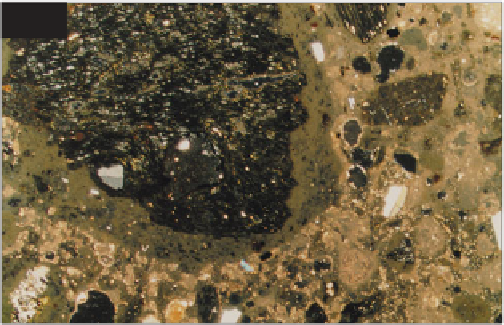Geoscience Reference
In-Depth Information
P
OZZOLANA
The advantages of pozzolanic additives to lime mortars
have been known since antiquity when the Greeks and
Romans refined their use, intentionally producing lime
mortars for underwater works. The Romans in particular
sought out pozzolanic pumice for use in lime concrete for
large-scale harbour structures around the Mediterranean.
It was thought so beneficial that in many cases they
transported them over great distances (Oleson
et al
., 2004).
Examination of these lime concretes shows clear evidence
of pozzolanic reaction rims around the pumice particles
(
292
). Crushed ceramic brick, tiles, and potsherds were
used in Roman lime mortars and concretes for small-scale
and terrestrial purposes (Siddall, 2000) (
293
). Brick dust
has been added to English lime renders since the 18th
century making them dark brown in colour (
294
). The
degree of pozzolanic activity of ceramic additives depends
on factors such as the firing temperature of the clay and
the composition, state, and particle size of the ceramic
product, all of which can be investigated microscopically.
The presence of other, more modern pozzolanas, such as
PFA and trass, is easily detected optically, owing to their
distinctive morphologies, while very finely divided mineral
additions, such as metakaolin, are too small to be seen
using optical microscopy alone. The detection of very
finely divided mineral additives relies on observation of
indirect evidence such as high optical density of the binder
and the presence of agglomerations of undispersed
material.
and even human hair have been used historically. As a
rule of thumb, goat hair is light coloured (commonly
white), while cattle hair is usually dark (commonly brown
or reddish-brown) and horse hair can be a variety of
colours. Goat and cattle hair are covered by tiny barbs
which hold the hairs in place within the mortar. Horse hair
has a smooth surface and consequently can be pulled
away from the hardened mortar by hand. Human hair was
rarely used because of its fineness and poor strength. It
should be noted that it is theoretically possible to contract
anthrax from infected hair within historic plaster, although
the risk is extremely low (English Heritage, 2001). Simple
contact reduction precautions and good hygiene practices
are advisable when handling historic plaster specimens.
M
IX PROPORTIONS
Modern, well mixed lime mortars typically have mix
proportions of around 1:3 (lime:sand). Historic lime
mortars often contain more lime with mix proportions of
1:1 or 1:2. However, historic mortars typically contain
more lime inclusions in the form of lumps of unmixed
lime, underburnt material, or hardburnt particles.
Although derived from the lime binder these inclusions
do not function as binder in the mortar and in terms of
performance can be regarded as a form of aggregate
(Leslie & Hughes, 2002). However, for the purposes of
matching, it is the original binder content including the
lime inclusions which is used, so the repair lime should
include similar types/amounts of inclusions (Ingham,
2003). In rare cases lime mortars were used historically
with no aggregate at all. For example, Figure
298
shows
I
NCLUSIONS
Impurities such as charcoal (
295
) or wood are often
observed in historic mortars. Small quantities of charcoal
usually originate accidentally as remnants of fuel from the
lime kiln. If large quantities of charcoal or furnace clinker
are present, then they were probably added deliberately to
colour the mortar black. Small inclusions of wood may
represent fuel remnants or possibly contamination by
fragments of the mortar board or plasterer's hawk.
Lumps of finely crystalline sparry calcite may be present
in lime mortars (
296
). These may originate as a hard
carbonate crust that can form on top and around the edges
of lime putty or 'coarse stuff' as it matures in pits or other
containers. This carbonated crust was often accidentally or
deliberately crunched into the mix prior to application and
is believed to aid the overall carbonation process.
Animal hair has historically been used as reinforcement
for lime plasters (
297
). Typically, around 4-8 kg of hair
was added to a cubic metre of plaster and the hair would
ideally be strong, soft, not too springy, and of various
lengths between 25 mm and 100 mm. Goat and cattle hair
are accepted as the best varieties, but less suitable horse
292
292
Lime concrete from the Roman harbour at
Corinth, Greece, showing a pumice aggregate particle
with a pozzolanic reaction rim (appears darker than
the carbonated lime binder); XPT, ×35.




